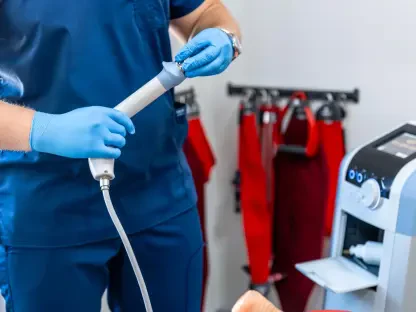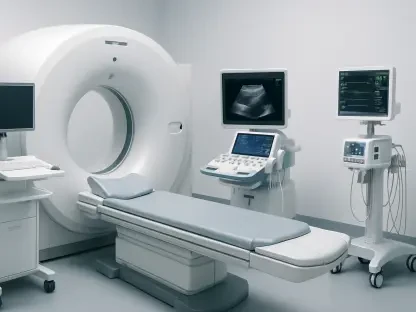As the medical technology sector approaches the latter half of the year, it stands on the brink of transformative shifts that promise to redefine healthcare delivery and industry dynamics. With persistent challenges like widespread hypertension affecting millions and the relentless pace of technological innovation pushing boundaries, medtech companies are navigating a complex landscape brimming with both unprecedented opportunities and intricate uncertainties. From strategic mergers reshaping market structures to groundbreaking treatments offering new hope for chronic conditions, the industry is at a pivotal juncture. This exploration delves into four critical developments that are set to dominate discussions among healthcare providers, investors, and industry watchers. These trends not only highlight the sector’s hunger for growth but also underscore the delicate balance between innovation and regulation. Each area reflects a unique facet of medtech’s evolution, promising to influence patient outcomes and corporate strategies alike in the coming months.
Strategic Mergers Driving Sector Expansion
The medtech industry continues to rely heavily on mergers and acquisitions as a primary engine for growth, often described as the lifeblood of the sector. After a fluctuating start to the year, with early blockbuster deals giving way to a temporary slowdown due to market instability, a notable resurgence has emerged since mid-year. A standout transaction, the $17.5 billion merger between BD and Waters, marks the largest deal of the year, showcasing a robust appetite for strategic consolidation. Other significant moves, such as Stryker’s nearly $5 billion acquisition of Inari Medical earlier in the year, further illustrate how companies are positioning themselves to capture emerging opportunities. Analysts remain optimistic, suggesting that this momentum is likely to persist, driven by the need to access new technologies and expand market reach. Despite external pressures like economic volatility, the consensus points to firms adopting an opportunistic approach, targeting diverse markets to bolster their portfolios and strengthen competitive edges.
Beyond the headline-grabbing deals, the broader implications of this M&A wave are reshaping the competitive landscape. Smaller yet strategic acquisitions are also gaining traction, enabling companies to fill specific gaps in their offerings or enter niche segments with high growth potential. This trend is not merely about scale but about creating synergies that enhance innovation and operational efficiency. For instance, acquiring firms often gain access to cutting-edge research or specialized talent, which can accelerate product development cycles. However, challenges remain, as integrating disparate corporate cultures and technologies can pose significant hurdles. Market observers note that successful integration will be key to realizing the full value of these transactions. As the year progresses, the focus will likely shift toward how these newly formed entities leverage their combined strengths to address unmet needs in healthcare, setting a precedent for future dealmaking strategies across the sector.
Innovative Treatment for Hypertension on the Rise
Renal denervation is capturing significant attention as a minimally invasive solution for uncontrolled hypertension, a condition affecting nearly half of American adults. With only a fraction of those affected managing their condition effectively, the market potential for this treatment is immense. A critical milestone looms with an anticipated Medicare national coverage determination expected in October, which will clarify the reimbursable population and could dramatically expand access to the procedure. Medtronic stands at the forefront with its FDA-approved Symplicity Spyral system, backed by extensive clinical data and a strong sales network. Yet, the field is becoming increasingly crowded as competitors like Recor Medical, with its Paradise system, and Boston Scientific, through recent strategic moves, enter the fray. This competitive dynamic signals a burgeoning market, though experts caution that widespread clinical adoption may face delays due to the need for specialized physician training and the establishment of effective referral pathways.
The promise of renal denervation extends beyond immediate patient benefits to broader implications for healthcare systems grappling with the burden of chronic conditions. By offering a treatment that targets the underlying mechanisms of hypertension through nerve disruption, this approach could reduce reliance on long-term medication for many patients, potentially lowering costs and improving quality of life. However, the journey to mainstream acceptance involves overcoming significant hurdles, including educating healthcare providers on the procedure’s benefits and ensuring consistent outcomes across diverse patient populations. Support from medical organizations, such as endorsements in hypertension management guidelines, lends credibility, yet the pace of integration into standard care remains uncertain. As stakeholders await the Medicare decision, the focus is on how quickly infrastructure can adapt to support this innovative therapy, setting the stage for its role in transforming cardiovascular care in the near term.
Regulatory Funding at a Critical Juncture
The reauthorization of the Medical Device User Fee Amendments (MDUFA) for the period spanning 2027 to 2032 represents a pivotal moment for regulatory oversight in medtech. This process, which began with a public hearing in August, determines the funding levels for the FDA’s Center for Devices and Radiological Health, combining industry fees with congressional appropriations. Building on the current agreement’s substantial budget increase, the FDA is advocating for additional resources to maintain its science-driven mission amid concerns over potential federal budget cuts. The stakes are high, as these funds are essential for ensuring timely device approvals and robust postmarket surveillance. Industry leaders and regulatory officials alike stress the importance of a well-resourced agency to keep pace with the rapid innovation characterizing the sector, while also safeguarding patient safety through rigorous evaluation processes.
Concerns among stakeholders, including patient advocacy groups, center on the risk of funding shortfalls if congressional support does not align with historical levels. Such a scenario could lead to reduced industry contributions, potentially compromising the FDA’s ability to fulfill its mandate. Voices from the advocacy community highlight the need for transparency in how fees are allocated, particularly emphasizing investments in postmarket safety monitoring to address long-term device performance issues. The ongoing negotiations, set to unfold over the next several months, are seen as a balancing act between industry interests and public health priorities. There is broad consensus on the necessity of reauthorization, yet debates persist over the specifics of funding distribution and the extent to which resources should prioritize emerging challenges like cybersecurity in medical devices. The outcome of these discussions will likely shape the regulatory environment for years to come, influencing how quickly and safely new technologies reach the market.
Competitive Dynamics in Surgical Robotics
Medtronic’s entry into the surgical robotics arena with its Hugo system poses a direct challenge to Intuitive Surgical’s longstanding dominance, anchored by the widely adopted da Vinci platform. With a nearly 25-year head start, Intuitive benefits from a deeply entrenched ecosystem, extensive surgeon training programs, and a vast installed base of systems. Medtronic, having submitted Hugo for FDA approval for urology procedures earlier this year, is gearing up for a U.S. market launch by April 2026, following earlier regulatory clearance in Europe. The system is also being studied for additional applications, including hernia and gynecologic surgeries, signaling an ambitious push into soft tissue robotic surgery. While Medtronic views Hugo as a vital growth driver for its surgical business, which has been impacted by the broader shift to robotics, market analysts express skepticism about its ability to significantly erode Intuitive’s market share given the latter’s established technological and clinical advantages.
Despite the uphill battle, there are pathways through which Hugo could carve out a niche in this competitive space. Some industry observers suggest that the system might appeal to hospitals looking to replace aging robotic platforms or to surgeons already familiar with Medtronic’s broader portfolio of surgical instruments. The potential for cost-effective solutions or tailored features could further bolster its case in specific market segments. However, the challenge lies in overcoming the inertia of surgeon loyalty and the seamless integration that Intuitive’s systems offer within hospital workflows. Medtronic’s strategy hinges on leveraging its reputation and existing relationships in the surgical field to drive adoption, but success will depend on demonstrating clear clinical and operational benefits. This rivalry underscores a broader trend of technological disruption in medtech, where innovation must contend with entrenched market leaders, shaping the future of minimally invasive surgery as competition intensifies.
Navigating Medtech’s Evolving Landscape
Reflecting on the medtech sector’s trajectory in the latter half of the year, it becomes evident that strategic acquisitions, innovative treatments, regulatory negotiations, and technological competitions define a period of dynamic change. The surge in mergers and acquisitions demonstrates a relentless drive for expansion, while renal denervation emerges as a beacon of hope for hypertension management, pending critical reimbursement decisions. The MDUFA reauthorization process reveals the delicate balance between funding and oversight, with stakeholders advocating for resources to ensure safety and innovation. Meanwhile, Medtronic’s foray into surgical robotics with Hugo sparks a conversation about market disruption, even as doubts linger about challenging established giants. Moving forward, industry players must prioritize seamless integration of acquired entities, accelerate physician training for novel therapies, advocate for balanced regulatory funding, and focus on differentiating new technologies through tangible benefits. These actionable steps will be crucial in sustaining momentum and addressing the complex challenges that lie ahead, ensuring that the sector continues to advance patient care through strategic and innovative efforts.









